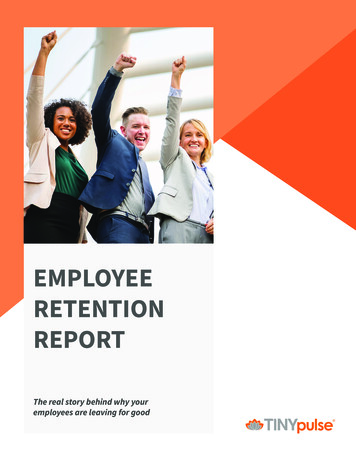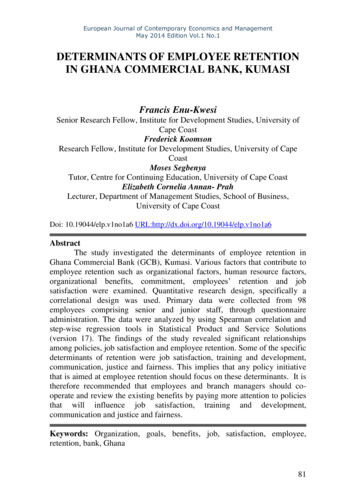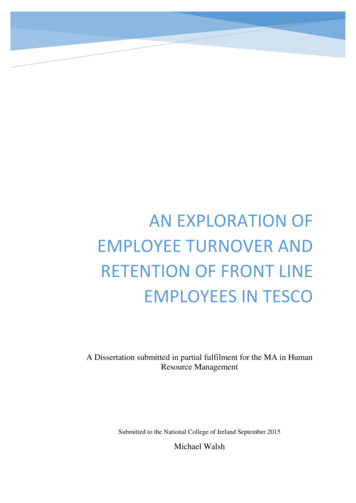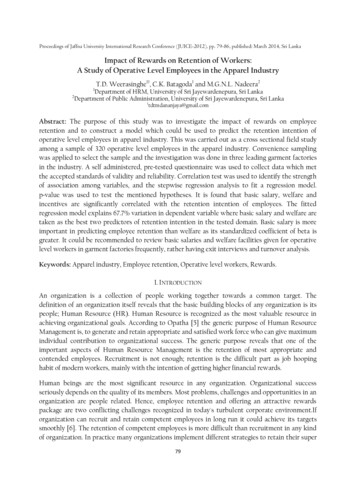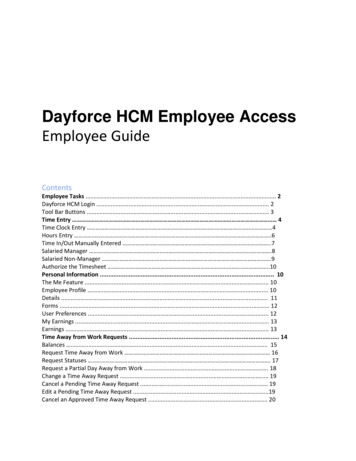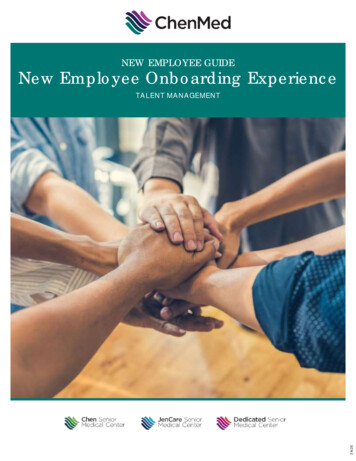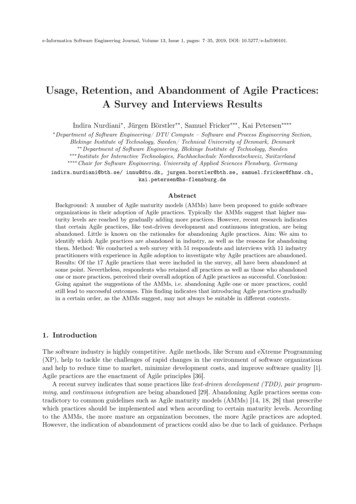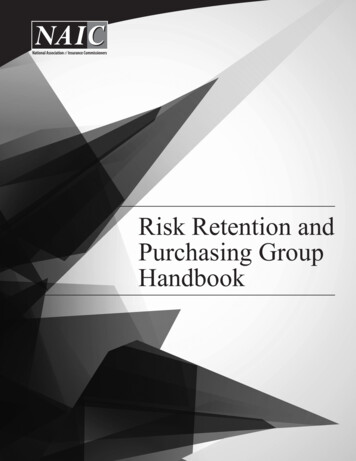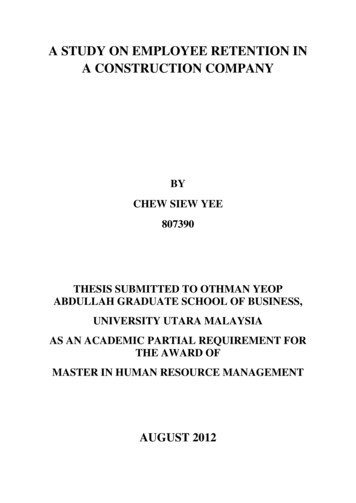
Transcription
A STUDY ON EMPLOYEE RETENTION INA CONSTRUCTION COMPANYBYCHEW SIEW YEE807390THESIS SUBMITTED TO OTHMAN YEOPABDULLAH GRADUATE SCHOOL OF BUSINESS,UNIVERSITY UTARA MALAYSIAAS AN ACADEMIC PARTIAL REQUIREMENT FORTHE AWARD OFMASTER IN HUMAN RESOURCE MANAGEMENTAUGUST 2012
DECLARATIONThis declaration is to clarify that all of the submitted contents of this project paper areoriginal in its stature, excluding hose, which have been, acknowledge specifically in thereferences. All the work process involved is from my own idea and work. All of thecontent of this project paper has been submitted as a part of partial fulfilment of Masterof Human Resource Management programme. I hereby declare that this project paperis the work of my own excluded for the references document and summaries that hasbeen acknowledged.Chew Siew YeeOthman Yeop Abdullah Graduate School of BusinessUniversity Utara Malaysia06010 SintokKedah DarulAmani
ii
PERMISSION TO USEIn presenting this project paper is partial fulfilment of the requirements for a postgraduatedegree from Universiti Utara Malaysia. I agreed that the University Library make a freelyavailable for inspection. I further agree that the permission for coping of this project paper inany manner, in whole or in part, for scholarly purpose may be granted by supervisor (s), intheir absence by the Dean of Othman Yeop Abdullah Graduate School of Business. It isunderstood that any copying or publication or use of this project paper or parts thereof forfinancial gain shall not be given to me and to Universiti Utara Malaysia for any scholarly usewhich may be made of any material from my project paper.Request for permission to copy or make other use of material in this project paper, in wholeor in part should be addressed to:Dean of Othman Yeop Abdullah Graduate Shool of BusinessUniversity Utara Malaysia06010 UUM SintokKedah Darul Amaniii
ABSTRAKBanyak syarikat pembinaan telah mengalami keciciran pekerja yang menyebabkankesan buruk kepada industry pembinaan.Kajian telah dijalankan bertujuan untukmengenal pasti punca keciciran dan cara mengatasinya.Kajian dijalankan dengankaedah “questionnaire”, sebanyak 100 peserta daripada 200 yang dipilih secara rawaktelah melengkapkan questionnaire tersebut. Kajian menujukkan, kepuasan kerja danmotivasi adalah mempengaruhi pekerja untuk kekal di syarikat tersebut. Selain itupunca keciciran adalah dipengaruhi oleh kemudahan, wakut bekerja, susunankakitangan dan kecuaian semasa menjalankan process pemilihan dan pengambilan.iv
ABSTRACTMany construction companies experiences high attrition, which negatively impacts theconstruction industry. This study’s objective was to identify employees are leaving andpropose retention initiatives.The research instrument used to obtain data wasquestionnaire. A total of 200 questionnaires were randomly distributed to employeesfrom construction companies.Researcher has also conducted interview with thesubject expert. However, only 100 respondents returned the completed questionnaires.Correlation analysis was used to test the inter correlation between the variables.Correlation result shows that these two variables of motivation and job satisfactionwere correlated with employee retention in the organization. The Pearson correlationused to measure the significance of linear bivariate between the independent anddependent variables thereby achieving the objectives of this study. Linear regressionsused to determine the relationship between independent and dependent variables, thedirection of the relationship and strength of the relationship. Results indicate attritionis associated with compensation, work hours, staffing and improper selection/hiring ofemployees. These findings show that the related factors should be given attention toretain employees in the organisation.v
ACKNOWLEDGEMENTSFirst and foremost let me sincerely thanks to my Project Supervisor and advisor EnMohmad Amin Bin Mad Idris for the great opportunity and blessings that he has takenhis time in bringing his experience, expertise to bear on an important section; toprovide excellent support during the writing process to make this project paper.I render my whole hearted thanks to all the other respected faculties of the managementdepartment, lecturers and all other office staff for their assistance and co-operationsgiven to me in regard to this work.Thanks to all the human resource professionals, my superior, colleagues and fellowconsultants and clients whose thoughts and actions have inspired and contributed to thecontinuing quest for human capital management practices that produce businesssuccess. Their ideas and wisdom enrich this project paper a reality.Once again I take this opportunity to convey my thanks to each and every person whohelped me directly and indirectly who responded to the surveys with honesty, faith thatmaybe their comments would help to make things better.I thank my parents and all other family members for their valuable support andencouragement in completion of this project paper.CHEW SIEW YEE (807390)vi
TABLE OF CONTENTSPageCoverDeclarationiCertificate of Project PaperiiPermission to useiiiAbstrak (in Bahasa Malaysia)ivAbstractvAcknowledgmentviTable of Contentvii-ixList of TablexList of FigurexiList of AbbreviationxiiCHAPTER 1INTRODUCTION1.1Background of the Study1-221.2Problem Statement23-271.3Research Questions281.4Research Objective281.5Theoretical Framework281.6Hypotheses291.7Significance of the study291.8Scope of the Research291.9Limitation of the study30vii
CHAPTER 2LITERATURE REVIEW2,1Introduction312,2Comparison alternatives322.3Intension to quit332.4The link between satisfaction & commitment352.5Training & Career Development392.6Employee motivation and Job Satisfaction42-562.7Literature Summary Review57CHAPTER 3RESEARCH METHODOLOGY3.1Introduction583.2Research Design613.3Population and sample613.4Data Collection Technique613.5Research Instruments623.6Data Analysis Method633.7Summary63viii
CHAPTER 4FINDINGS AND DATA ANALYSIS4.1Introduction644.2Respondents’ profile64-70CHAPTER 5DISCUSSIONS, CONCLUSTION & sion & S (Appendix A)ix
LIST OF TABLES4.1Respondents ID (Gender)4.2Race of Respondents4.3Qualification of Respondents4.4Position of Respondents4.5Year of Service of Respondents4.6Income Range of Respondents4.7Respondents’ most important factor in motivation4.8Respondents’ most important factor in job satisfaction4.9Respondents’ most effective Employee Retention Strategies4.10Correlation between motivation & employee retention4.11Correlation between job satisfaction & employee retention5.1Degree of employer/employee contr9ol over decision to leave5.2Four strategies Employer of Choice5.3Talent Engagement Strategies in Actionx
LIST OF FIGURE1.2Theoretical Framework2.1A model of the content theory of motivation2.2Maslow’s theory of needs2.3Hygiene Factors2.4Equity Theory2.5The Reinforcement Theories/Operant Conditioning2.6Survey Processxi
LIST OF ABBREVIATIONSHR:Human ResourceUUM:University Utara Malaysiaxii
CHAPTER 1 - INTRODUCTION1.1BACK GROUND OF THE STUDYAn organization is a set up where individuals come together and work in unison to achievea common goal is called as organization. Individuals working together in an organizationto earn their bread and butter as well as make profits are called employees. Employees arethe lifeline of an organization and contribute effectively to its successful running andprofit making.An organization cannot survive if the employees are not serious about it and are moreconcerned about their personal interests.In today‟s intensely competitive and global marketplace, maintaining a competitiveadvantage by becoming a low cost leader or a differentiator puts a heavy premium onfacing a highly committed or competent workforce. Competitive advantage lies not just indifferentiating a product or service or in becoming the low cost leader but in also beingable to tap the company‟s special skills or core competencies and rapidly respond tocustomer‟s needs and competitor‟s moves. In other words competitive advantage lies inmanagement‟s ability to consolidate corporate-wide technologies and production skillsinto competencies that empower individual businesses to adapt quickly to changingopportunities.In a growing number of organizations human resources are now viewed as a source ofcompetitive advantage. There is greater recognition that distinctive competencies areobtained through highly developed employee skills, distinctive organizational cultures,management processes and systems.This is in contrast to the traditional emphasis ontransferable resources such as equipment increasingly it is being recognized thatcompetitive advantage can be obtained with a high quality workforce that enables1
The contents ofthe thesis is forinternal useronly
Figure 5.3 Talent Engagement Strategies in Action111
REFERENCESAbelson M. A. (1987), „Examination of avoidable and unavoidable turnover‟ Journal ofApplied Psychology, vol. 72(3), pp. 382-386Allen N.J. & Meyer J.P. (1990), „The measurement and antecedents of affective, continuanceand normative commitment on the organization‟, Journal of Occupational Psychology,vol. 63(1), pp.1-18.Beach R., Brereton D. & Cliff D. (2003), Workforce turnover in FIFO mining operations inAustralia: An exploratory study, Centre for Social Responsibility in Mining, universityof Queensland & Sustainable Minerals Institute. http://www.csrm.uq.edu.au. AccessedNovember 2004.Boxall P., Macky K& Rasmussen E. (2003), „Labour turnover and retention in New Zealand;the causes and consequences of leaving and staying with employers‟, Asia PacificJournal of Human Resources, vol.41920, pp. 196-214.Chang E. (1999), „Career commitment as a complex moderator of organizationalcommitment and turnover intention‟, Human Relations, vol. 52(10), pp. 1257-1278.Chartered Institute of Personnel and Development (2004), Fact sheet on employee turnoverand retention.Davies D., Taylor R. & Savery L. (2001), „The role of appraisal, remuneration and training inimproving staff relations in the Western Australian accommodation industry: acomparative study‟, Journal of European Industrial Training, vol.25(6/7), pp. 366-373.Elangovan A.R. (2001), „Causal ordering of stress, satisfaction and commitment, andintention to quit: a structural equations analysis‟, Leadership & OrganizationDevelopment Journal, vol. 22(4), pp.159-165.Firth L., Mellor D.J., Moore K.A. & Loquet C. (2004), „How can managers reduce employeeintention to quit?‟, Journal of Managerial Psychology, vol.19(2), pp.170-187Griffeth R.W, Hom P.W. & Gaertner S. (2000), „A Meta-analysis of antecedents andcorrelates of employee turnover: Update, moderator tests and research Implications forthe next millennium‟, Journal of Management vol. 26(3), pp.463-488.Guthrie J.P. (2001), „High involvement work practices, turnover and productivity: Evidencefrom New Zealand‟, Academy of Management Journal vol. 4491), pp. 180-190.112
Hegney D., Rogers-Clark C., Gorman D., Baker S. & McCarthy, A. (2001), Factorsinfluencing the recruitment and retention of nurses in rural and remote areas inQueensland, Department of Nursing, University of Southern Queensland.Huselid M.A., (1995), „The impact of human resource management practices on turnover,productivity and coporte financial performance‟, Academy of Management Journal, vol.38(3), pp.635-672.IDS (2000), Improving staff retention, IDS Studies No. 692, July 2000.IDS (2004), Improving staff retention, IDS HR Studies No. 765, Jan 2004.Kirschenbaum A. & Mano Negrin R. (1999), „Underlying labor market dimensions of“opportunities”: The case of employee turnover‟, Human Relations, vol. 52(10), pp.1233-1255.Kirschenbaum A. & Weisberg J. (2002), „Employee‟s turnover intentions and job destinationchoices‟, Journal of Organizational behaviour, vol. 23(1), pp.109-125Lee T.W. & Mitchell T. R. (1994), „An Alternative approach: The unfolding model ofvoluntary employee turnover‟, Academy of Mangement Review vol. 19(1), pp. 51-89.Lum L., Kervin J., Clark K., Reid F. & Sirola W. (1998), „Explaining nursing turnover intent:job satisfaction, pay satisfaction or organizational commitment?‟, Journal ofOrganizational behaviour, vol. 19(3), pp. 305-320.Martin C. (2003) „Expalining lbour turnover: Empirical evidence from UK establishments‟,Labour, vol. 17(3), pp. 391-412.Mobley W.H., Griffeth R. W., Hand, H.H. & Meglino, B.M. (1979) „Review and conceptualanalysis of the employee turnover process‟, Psychological Bulletin vol. 86(3), pp. 493522.Morrell K.M, Loan-Clarke J. & Wilkinson J (2004), „Organisational change and employeeturnover‟, Personnel Review, vol 33(2), pp. 161-173.Politt D. (2003) „Shift-pattern switch improves staff turnover and recruitment at Seeboard‟,Human Resource Management International Diigest, vol. 11(1), pp. 12-14.Politt D. (2004) „Marina Developments staff get a lift from boatyard training‟ HumanResource Management, vol. 12 92), pp. 14-16.113
Shah C.& Burke G. (2003), Labour mobility: demographic, labour force and educationeffects and implications for VET, Report to ANTA, Centre for the Economics ofEducation and Training, Monash.Statistics Canada (2003), „Innovative work practices and labour turnover in Canada‟.The Evolving Workplace Series.Tang T. L. P., Kim J. W & Tang D.S.H 92000), „Does attitude toward money moderate therelationship between intrinsic job satisfaction and voluntary turnover? Human Relations,vol. 53(2), pp. 213-245.Taplin I.M, Winterton J. & Winterton R. (2003), „Understanding labour trunvoer in a labourintensive industry: Evidence from the British clothing industry‟ Journal of ManagementStudies, vol. 40 (4), pp. 1021-1046.114
A STUDY ON EMPLOYEE RETENTION IN A CONSTRUCTION COMPANY BY CHEW SIEW YEE 807390 THESIS SUBMITTED TO OTHMAN YEOP ABDULLAH GRADUATE SCHOOL OF BUSINESS, UNIVERSITY UTARA MALAYSIA AS AN ACADEMIC PARTIAL REQUIREMENT FOR THE AWARD OF MASTER IN HUMAN RESOURCE MANAGEMENT AUGUST 2012 . i DECLARATION This


